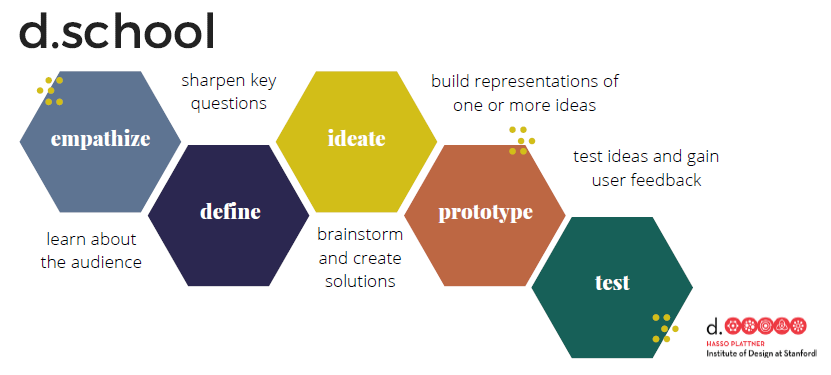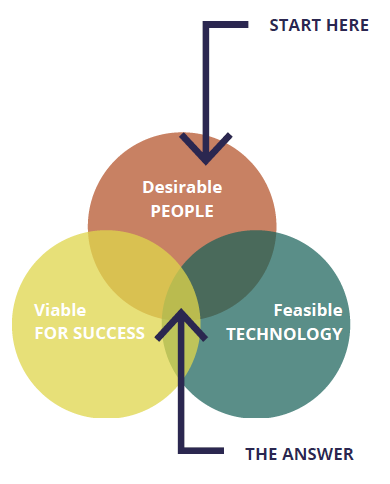4 Homebase
WHAT in a Brief
Design thinking is a methodology that provides a solution- based approach to solving problems. It combines what’s desirable from a human point of view with what is technologically feasible and economically viable. It’s useful in tackling loosely defined, complex problems by understanding human needs.
The Origins of Design Thinking
Author: Teo Yu Siang and Interaction Design Foundation.
Both the industrial revolution and World War II pushed the boundaries of what we thought was technologically possible. Engineers, architects and industrial designers—as well as cognitive scientists—then began to converge on the issues of collective problem solving, driven by the significant societal changes that took place at that time. Design thinking emerged, or should we say converged, out of the muddy waters of this chaos from the 50s and 60s onwards.
Cognitive scientist and Nobel Prize laureate Herbert A. Simon was the first to mention design thinking as a way of thinking in his 1969 book, The Sciences of the Artificial. He then went on to contribute many ideas throughout the 70s which are now regarded as principles of design thinking.
From the 1970s onwards, design thinking started to combine the human, technological and strategic needs of our times and progressively developed over the decades to become the leading innovation methodology it is today. Design thinking continues to gain ground across a wide range of industries and is still explored and enhanced by those at the forefront of the field.
A Conceptual Model of Design Thinking (Carlgren, Rauth & Elmquist, 2016)
Essentially, design thinking is a set of mindsets, principles, practices, and techniques (cf. above figure by Carlgren, Rauth & Elmquist, 2016), which resemble the way certain
designers work and approach problems that go beyond a product’s look.
(For a more in-depth explanation, refer The Different Design Thinking Discourses from the This Is Design Thinking site)
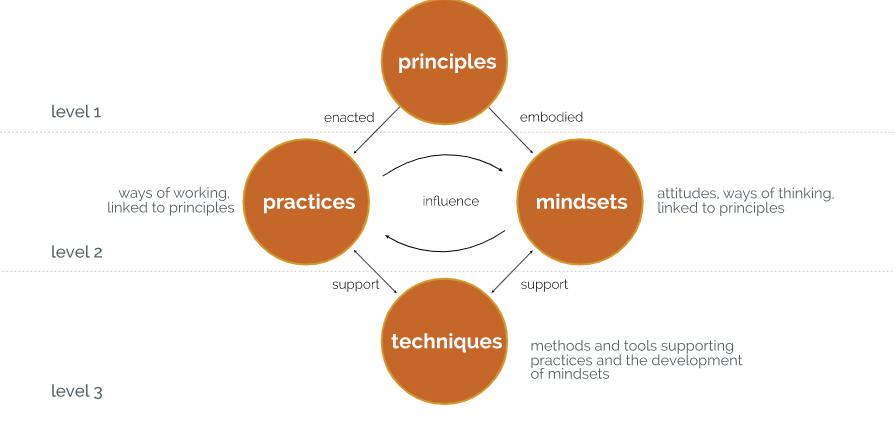
Learn More About Design Thinking
Design consultancy IDEO’s design kit is a great repository of Design Thinking tools and case studies. Design Kit and This is Design Thinking are a full of design thinking resources.
To keep up with recent developments in Design Thinking, read Design Thinking pioneer Tim Brown’s blog.
WHY at a Glance
Why Is Design Thinking so Important in Today’s World?
Author: Teo Yu Siang and Interaction Design Foundation.
Over recent decades, it has become crucial to develop and refine skills which allow us to understand and act on rapid changes in our environment and behavior. The world has become increasingly interconnected and complex, and design thinking offers a means to grapple with all this change in a more human-centric manner.
Design teams use design thinking to tackle ill-defined or unknown problems (otherwise known as wicked problems) because the process reframes these problems in human-centric ways, and allows designers to focus on what’s most important for users. Design thinking offers us a means to think outside the box and also dig that bit deeper into problem solving. It helps designers carry out the right kind of research, create prototypes and test out products and services to uncover new ways to meet users’ needs.
The design thinking process has become increasingly popular over the last few decades because it was key to the success of many high-profile, global organizations—companies such as Google, Apple and Airbnb have wielded it to notable effect, for example. This outside the box thinking is now taught at leading universities across the world and is encouraged at every level of business.
Design thinking improves the world around us every day because of its ability to generate ground-breaking solutions in a disruptive and innovative way. Design thinking is more than just a process, it opens up an entirely new way to think, and offers a collection of hands-on methods to help you apply this new mindset.
A Bit About the d.school
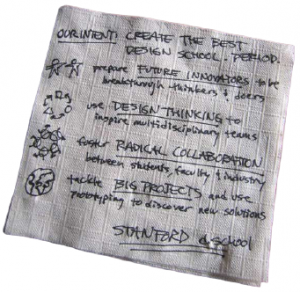
The d.school was founded in 2005, and became quickly recognized as a thought leader in human-centered design, and experiential learning. In 2012, they began inviting professionals with expertise in their respective fields to join the d.school to advance an ambitious project To create systems-level change in the world.
d.school POV: We believe everyone has the capacity to be creative.
Design Thinking Requires Hands-On Experience
It may be obvious, but to learn design thinking, you need to be able to do design thinking. We become experts at our jobs because we understand our work inside and out. Design thinking is no different, we become proficient as we work through solving problems while using the process and methods. There are many different approaches to design thinking. Whether you choose the Double Diamond by Design Council, the Stanford d.school method or the IDEO mindsets, as user you need to master using design thinking to get results. Theory is valuable and required, but being adept at the practice is by far the most important driver of success.
Design Thinking Thrives on Feedback and Iteration.
The most important ritual of the design process is feedback. It is also important to debrief after running a session in a class, team, or with clients. For example, at the d.school there is the daily debrief session. Instead of running to their respective offices when class is over, the teaching team gathers at the back of the classroom, reflects on how the session went, and listens to students’ feedback.
Design Thinking Solves Real-World Problems
Real-world projects are the key to design thinking since they have to be structured without artificial constraints or boundaries. This transforms the learning experience: from focusing on the grade to working on a problem which is will genuinely make a difference in the world. For example, if a class is about creating a business, students should create a real business. If it’s about improving the water supply in developing countries, they should build a solution that puts a clean glass of water in the hand of someone who needs it.
The Five Stages of Design Thinking
The Hasso Plattner Institute of Design at Stanford, commonly known as the d.school, describes design thinking as a five-stage process. It’s important to note these stages are not always sequential and designers can often run the stages in parallel, out of order and repeat them in an iterative fashion.
Stage 1: Empathize—Research Your Users’s Needs
The first stage of the design thinking process allows you to gain an empathetic understanding of the problem you’re trying to solve, typically through user research. Empathy is crucial to a human-centered design process like design thinking because it allows you to set aside your own assumptions about the world and gain real insight into users and their needs.
Stage 2: Define—State Your Users’ Needs and Problems
In the Define stage, you accumulate the information you created and gathered during the Empathize stage. You analyze your observations and synthesize them to define the core problems you and your team have identified so far.
Stage 3: Ideate—Challenge Assumptions and Create Ideas
The solid background of knowledge from the first two phases means you can start to “think outside the box”, look for alternative ways to view the problem and identify innovative solutions to the problem statement you’ve created.
Stage 4: Prototype—Start to Create Solutions
This is an experimental phase, and the aim is to identify the best possible solution for each of the problems identified during the first three stages. Design teams will produce a number of inexpensive, scaled-down versions of the product (or specific features found within the product) to investigate the problem solutions generated in the previous stage.
Stage 5: Test—Try Your Solutions Out
Designers or evaluators rigorously test the complete product using the best solutions identified in the Prototype phase. This is the final phase of the model but, in an iterative process such as design thinking, the results generated are often used to redefine one or more further problems. Designers can then choose to return to previous stages in the process to make further iterations, alterations and refinements to rule out alternative solutions.
WHAT at a Glance

IDEO uses divergent and convergent thinking to quickly and intentionally explore possibilities, test insights and iterate.
What is Human-Centered Design?
- The needs of the people
- The possibilities of technology
- The requirements of success
Mindsets
Creative Confidence: Trust in your ability to come up with creative solutions to big problems and dive in.
Empathy: Step into someone else’s shoes and start to solve problems from their perspective.
Embrace Ambiguity: Give yourself permission to explore so that the right answer can reveal itself.
Make it: Get ideas out of your head and into people’s hands so you can learn from them and improve.
Learn From Failure: Experiment and prototype to learn what doesn’t work, so you can learn what will.
Iterate, Iterate, Iterate: Keep testing, learning from, and evolving your ideas so you can get them just right.
Optimism: Embrace the idea that a solution is out there and that you can find it.
HOW at a Glance
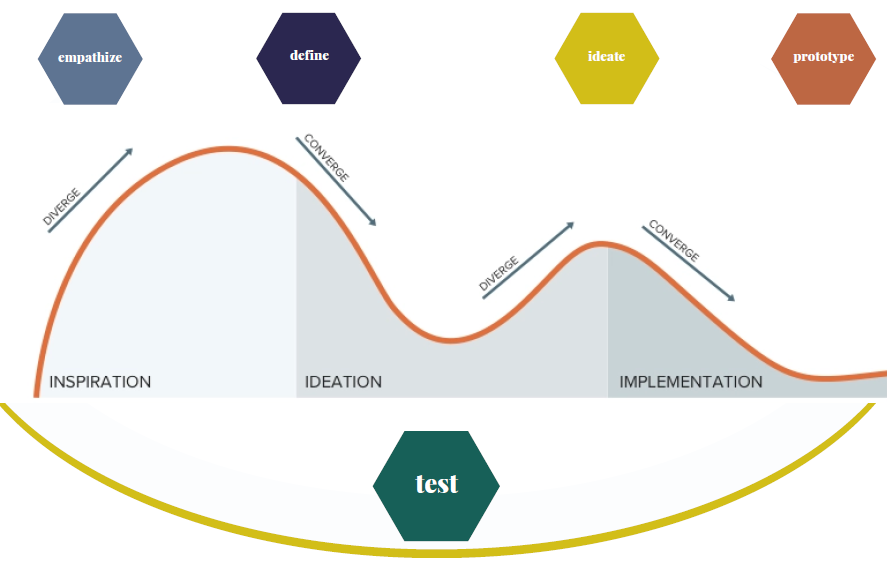
Inspiration (Empathy/Define)
This phase, is intended to help you learn how to better understand people by observing their lives, listening to their hopes and desires, and understanding the real design challenge.
Frame Your Challenge
Start with a big question that you want to design for. Think about the impact you want to have and start with a challenge that you are excited to tackle.
Create a Plan
Think ahead about what you want to learn more about, who you can learn from, and where you can learn. Ask questions that lead to deeper understanding of and empathy for the people you’re designing for.
Go Out and Research
Seek inspiration by going out into the world and learning from Interviews, Immersion, Expert Interview, and Analogous Inspiration. Talk with people who represent extreme perspectives to push your thinking and challenge your assumptions—remember that they are the experts on their own experiences.
Ideation (Define, Ideate, Prototype)
The goal of this phase is to help make sense of everything that you’ve heard, generate tons of ideas, identify opportunities for design, and prototype your solutions.
Synthesis
Make sense out of what you learned during Inspiration to uncover opportunities to design for by Downloading Your Learnings, Finding Themes and Insights, and Creating
“How Might We”Questions.
Brainstorming
Energize your team and drum up a staggering amount of innovative ideas. Keep these rules in mind: defer judgement; encourage wild ideas; build on the ideas of others; stay focused on the topic; one conversation at a time; be visual; and go for quantity.
Prototyping
Bring ideas to life quickly so you can test them, get feedback, and continue to improve your idea, getting solutions that work out in the world. Try Storyboarding, Rapid Prototyping, Testing and Getting Feed-back, and Integrating Feedback.
Implementation (Test & Iterate)
In the Implementation phase, solutions come to life and are tested in real time. The goal is to learn from the users and to evolve the solution further. It is important to test with the mindset that the solution could fail and that you may need to keep iterating. Always keep the very people you’re looking to serve at the heart of the process.
Design thinking is an iterative, non-linear process that relies on intuition, the ability to recognize patterns, and to construct ideas that are desirable, feasible, and viable.
Human-Centered Design, is a mindset that overlays design thinking to ensure that the solutions are truly relevant and beneficial for the people they are intended to serve.

